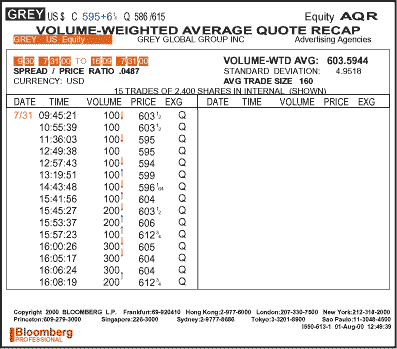TRADING TECHNIQUES
Can You Beat The VWAP?
Volume-Weighted Average Pricing
by Michael Tanksley, Ph.D.
What price should you aim to beat in your trades? Here's what the pros use.
J. Welles Wilder once said, "Somewhere amidst the maze of open, high, low, and close prices is a phantom line that is the real market." With that in mind, what numbers should you use to make your financial decisions? It's hard enough to make those decisions, but it's even harder when you aren't using numbers that truly represent the market. Volume-weighted average price (VWAP) is no phantom; it's the solution Wilder was looking for and what Wall Street professionals depend on.

FIGURE 1: GREY, VOLUME-WEIGHTED AVERAGE QUOTE. In a not-unusual occurrence, Grey traded all day at 604 but closed at 612-1/2.
On the brokers' floor, VWAP is the benchmark for rating trades.
Brokers use the number to know whether their trades are above or below
market value. VWAP represents what's really happening in the market because
it takes into account not just minute-to-minute prices but also trading
volume. That's why the biggest question brokers ask each other about any
trade is, "Did you beat the VWAP?"
Analysts know the closing price is often the result of a variant trade and may not represent the real market. Many times, a stock will trade within a certain price range throughout the trading day, only to have an oddly priced trade come through at day's end, setting the closing price outside that range. For example, take a look at the trading activity of Grey Global Group [GREY] on July 21. You can see on the volume-weighted average quote recap screen (Figure 1) that most of the day's trading occurred in a range from 594 to 605. But at the very end of the day, the closing trade was at 612-3/4 -- well outside of that range.
How could that happen? Sometimes, investors intentionally buy shares at a higher than market value at the close of trading in an attempt to inflate the value of the shares they already own. This type of market manipulation, known as marking or price pumping, is illegal but difficult to prove. Investors may try to mark shares at a higher price for tax purposes. They may donate a block of shares to a charitable organization and then, at the end of the day, purchase a small number of shares of the same company at an inflated price. They can use this manufactured, higher price to determine the value of their donation.
Marking has become such a serious problem at some exchanges that those exchanges have begun using VWAPs to determine closing prices. For example, on the Milan Stock Exchange, the closing price is a VWAP based on the last half hour of trading, and in Caracas, Venezuela, and Mexico City, closing prices are derived from the last 10 minutes of trading.
Sometimes, an out-of-the-ordinary closing price is the result not of illegal marking but of plain foolishness. On December 8, 1999, Primex Technologies stock [PRMX] rose 42% to 30-7/16 on volume 27 times its average daily trading volume. It was a case of mistaken identity: careless stock buyers purchased it, thinking they were buying shares of a closely held electronic trading company called Primex Trading.
Michael Tanksley is a physicist working at Bloomberg Financial doing research in technical analysis. He may be reached at 212 893-2756 or via E-mail at mtanksley@Bloomberg.net.
Excerpted from an article originally published in the December 2000 issue of Technical Analysis of STOCKS & COMMODITIES magazine. All rights reserved. © Copyright 2000, Technical Analysis, Inc.
Return to December 2000 Contents